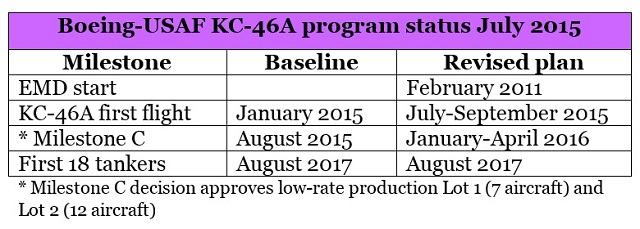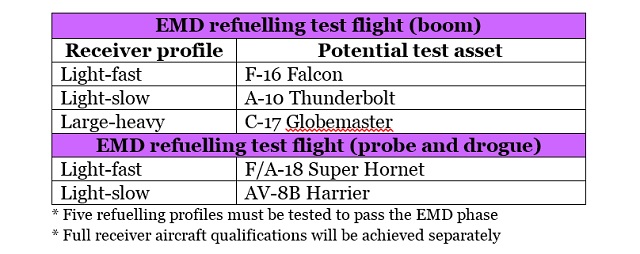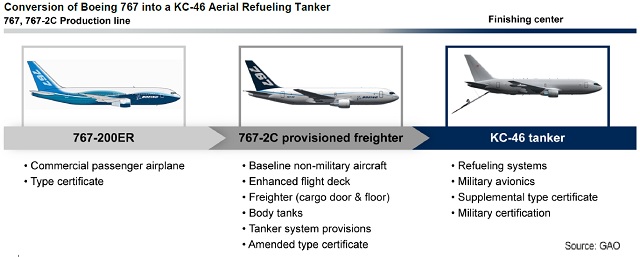The US Air Force’s programme executive officer for tankers is cautiously optimistic that Boeing can deliver its first 18 operational KC-46A Pegasus aircraft by August 2017 as required, but says he doesn’t have his “head in the sand” either.
The $50 billion tanker programme encountered significant delays late in the development phase due to wiring issues, software troubles and parts delivery delays, and the first KC-46 flight is expected to occur seven to nine months late, somewhere between now and September.
Brig Gen Duke Richardson, who heads the air force tanker directorate, says a schedule risk assessment completed this spring found some ways to make up for lost time, and concluded that the so-called required assets available target of 18 tankers is still achievable, despite changes to the first flight and low-rate production decision dates.

“When we first set up the programme, we had about six months of margin. In other, words Boeing was going to be able to deliver six months early to that last milestone. That margin is now gone,” Richardson said in a recent interview with Flightglobal. “I do think it’s achievable, but it’s not without risk.”
Richardson says the programme has been rephased since the well-documented wiring issue significantly set back production and flight testing, and the low-rate initial production decision that was due in August is now expected sometime between January and April next year. That decision will trigger contracts for Lot 1 (seven aircraft) and Lot 2 (12).
He expects KC-46A engineering and manufacturing development aircraft EMD-2 to do some heavy flying this October and November to assess the aircraft’s refuelling systems and identify any significant problems which could cause design changes. Once management is confident in the design, there will be a milestone C production decision.
The programme had expected to do much more flying prior to milestone C, but the rephasing means that only key refuelling test points will be checked off prior to production. For instance, Boeing had wanted to fly 400 test hours in 2014 but achieved just 3.5h with the EMD-1 727-2C first flight, and a larger portion of the 2,400h test programme will now be done post-milestone C.

Boeing Defense, Space & Security
“Things are taking longer than anticipated, but we are marching through the programme exactly as we built it,” Richardson says, noting that Pentagon leadership has been briefed and agrees with the rephasing changes. “We haven’t changed the structure. [Boeing has] not backed away from anything, by the way, in terms of their contractual commitment.”
The tanker buyer says Boeing is not going to be asking for more money either, since it is a fixed-price development programme and the first two production lots have a pre-negotiated price.
In summary, Richardson says the number of software issues has come down by 34% in the last quarter, with no “category one” issues remaining at this point. He says there is margin built into the revised schedule to deal with design flaws that might emerge in flight testing, but not too much margin.
The priority now is flying the first KC-46A and refuelling five different receiver types using the tail boom as well as the centreline and wing-mounted hose-and-drogue systems to complete development. The plan is to certify eight aircraft initially, then 11 more, including the KC-46 itself.
The Lockheed Martin F-35 Joint Strike Fighter is not currently on that list, but will eventually be approved. “That set of 19 does not include the F-35,” Richardson confirms.

Commenting about South Korea’s recent selection of the Airbus Defence & Space A330 multi-role tanker transport over Boeing’s offer, Richardson says that is not a concern to him. He is more interested in replacing the USAF’s fleet of 53-year-old Boeing KC-135s and 30-year-old McDonnell Douglas KC-10s.
“It’s not a disappointment to me. It might be to Boeing,” he says. “We do see benefits, obviously, with a larger tanker fleet out there from a cost-sharing perspective.”
He says the air force is fully committed to acquiring a fleet of 179 KC-46s and potentially more in the 2030s, and is willing to do it alone. But having partners to share logistics and training infrastructure helps, and partners could jointly pursue software and hardware upgrades and deal with parts obsolescence issues.
“If it’s like the KC-135, we’ll be flying this thing for 50 years,” he says.
Richardson is still upbeat about the upcoming tanker selection by Japan, which already flies KC-767 tanker types.
“The KC-46 is based on the 767, but it’s going to be much more capable than the 767s they have,” he says. “It’s Japan’s decision, and we’re going to bring them a tough decision to make.”
Boeing again faces competition from the modified A330 for the Japanese requirement.

Government Accountability Office April 2015
Source: FlightGlobal.com



















